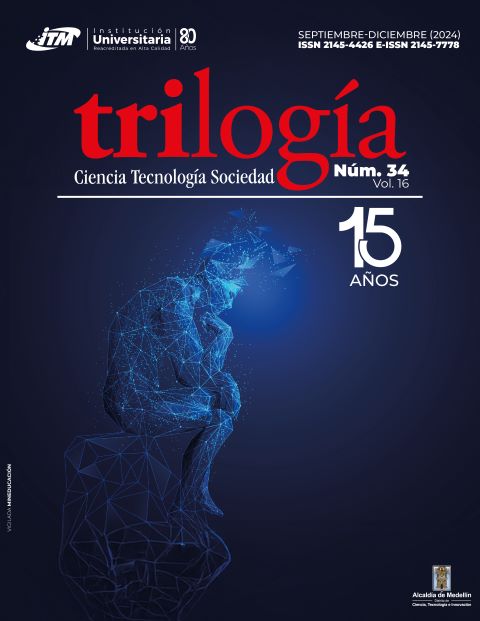Interacción social en el blended learning: una reflexión sobre la integración de la tecnología
Resumen
El presente artículo tuvo como objetivo promover la discusión sobre la importancia de la interacción social en el blended learning, con el fin de integrar las tecnologías en la educación superior, considerándolo como una de las posibles alternativas para superar su sesgo instrumental. Para alcanzar este objetivo, se revisaron los conceptos de integración tecnológica e interacción social, para luego analizar el caso de ChatGPT en las universidades, así como tres de los resultados de una revisión sistemática de la literatura sobre el estudio de la interacción en el blended learning, la cual permitió visibilizar el interés predominante por la implementación de tecnologías y enfoques de aprendizaje, las interacciones de los estudiantes con sus docentes y pares, y facilitó reconocer que una de las tendencias investigativas en la interacción social está centrada en las características de los estudiantes, particularmente con su motivación, actitudes, compromiso y trabajo con otros. En definitiva, las transacciones humanas, desde la interacción social, permiten la transmisión de significados que potencializan la transformación de los entornos de aprendizaje, ayudando a afrontar los retos de la educación superior, como la formación ética, la producción intelectual y el desarrollo de las habilidades humanas.
Referencias bibliográficas
Ateş Çobanoğlu, A. (2018). Student teachers’ satisfaction for blended learning via Edmodo learning management system. Behaviour & Information Technology, 37(2), 133–144. https://doi.org/10.1080/0144929X.2017.1417481
Balladares-Burgos, J. A. (2018). Diseño pedagógico de la educación digital para la formación del profesorado. Revista Latinoamericana de Tecnología Educativa, 17(1), 41–60. https://doi.org/10.17398/1695-288X.17.1.41
Bernard, R. M., Borokhovski, E., Schmid, R. F., Tamim, R. M., y Abrami, P. C. (2014). A meta-analysis of blended learning and technology use in higher education: from the general to the applied. Journal of Computing in Higher Education, 26(1), 87–122. https://doi.org/10.1007/s12528-013-9077-3
Blondel, V. D., Guillaume, J.-L., Lambiotte, R., y Lefebvre, E. (2008). Fast unfolding of communities in large networks. Journal of Statistical Mechanics: Theory and Experiment, 2008(10), artículo P10008. https://doi.org/10.1088/1742-5468/2008/10/P10008
Calderon, O., y Sood, C. (2018). Evaluating learning outcomes of an asynchronous online discussion assignment: a post-priori content analysis. Interactive Learning Environments, 28(1), 3–17. https://doi.org/10.1080/10494820.2018.1510421
Çardak, Ç., y Selvi, K. (2016). Increasing teacher candidates’ ways of interaction and levels of learning through action research in a blended course. Computers in Human Behavior, 61, 488–506. https://doi.org/10.1016/j.chb.2016.03.055
Castells, M. (2000). LA SOCIEDAD RED. La era de la información: economía, sociedad y cultura. (2.ª ed.). Siglo XXI Editores.
Castro, R. (2019). Blended learning in higher education: Trends and capabilities. Education and Information Technologies, 24(4), 2523–2546. https://doi.org/10.1007/s10639-019-09886-3
Castro-Rodríguez, M. M., Marín-Suelves, D., López-Gómez, S., y Rodríguez-Rodríguez, J. (2021). Mapping of Scientific Production on Blended Learning in Higher Education. Education Sciences, 11(9), artículo 494. https://doi.org/10.3390/educsci11090494
Çetin, A., y Özdemir, Ö. F. (2018). Mode-Method Interaction: The Role of Teaching Methods on The Effect of Instructional Modes on Achievements, Science Process Skills, and Attitudes Towards Physics. Eurasia Journal of Mathematics, Science and Technology Education, 14(5), 1815–1826. https://doi.org/10.29333/ejmste/85217
Chan, C. K. Y. (2023). A comprehensive AI policy education framework for university teaching and learning. International Journal of Educational Technology in Higher Education, 20(1), artículo 38. https://doi.org/10.1186/s41239-023-00408-3
Chan, C. K. Y., y Hu, W. (2023). Students’ voices on generative AI: perceptions, benefits, and challenges in higher education. International Journal of Educational Technology in Higher Education, 20(1), artículo 43. https://doi.org/10.1186/s41239-023-00411-8
Chan, E. Y. M. (2019). Blended Learning Dilemma: Teacher Education in the Confucian Heritage Culture. Australian Journal of Teacher Education, 44(1), 36–51. https://doi.org/10.14221/ajte.2018v44n1.3
Chen, R. (2016). Learner Perspectives of Online Problem-Based Learning and Applications from Cognitive Load Theory. Psychology Learning and Teaching, 15(2), 195–203. https://doi.org/10.1177/1475725716645961
Cheng, G., y Chau, J. (2015). Exploring the relationships between learning styles, online participation, learning achievement and course satisfaction: An empirical study of a blended learning course. British Journal of Educational Technology, 47(2), 257–278. https://doi.org/10.1111/bjet.12243
Ciudad Gómez, A., y Valverde Berrocoso, J. (2021). Perception of the MANCOMA model among undergraduate accounting students. PUBLICACIONES, 51(2), 419–441. https://doi.org/10.30827/publicaciones.v51i2.15941
Donnelly, R. (2010). Harmonizing technology with interaction in blended problem-based learning. Computers & Education, 54(2), 350–359. https://doi.org/10.1016/j.compedu.2009.08.012
Dahlstrom-Hakki, I., Alstad, Z., y Banerjee, M. (2020). Comparing synchronous and asynchronous online discussions for students with disabilities: The impact of social presence. Computers & Education, 150, artículo 103842. https://doi.org/10.1016/j.compedu.2020.103842
Drysdale, J. S., Graham, C. R., Spring, K. J., y Halverson, L. R. (2013). An analysis of research trends in dissertations and theses studying blended learning. The Internet and Higher Education, 17, 90–100. https://doi.org/10.1016/j.iheduc.2012.11.003
Ebner, M. (2022). 2022 EDUCAUSE Horizon Report | Teaching and Learning Edition. https://library.educause.edu/-/media/files/library/2022/4/2022hrteachinglearning.pdf
Engelbertink, M. M. J., Kelders, S. M., Woudt- Mittendorff, K. M., y Westerhof, G. J. (2022). The added value of autobiographical reflexivity with persuasive technology for professional identities of Social Work students: a randomized controlled trial. Social Work Education, 41(5), 767–786. https://doi.org/10.1080/02615479.2021.1888910
Finfgeld-Connett, D. (2014). Use of content analysis to conduct knowledge-building and theory-generating qualitative systematic reviews. Qualitative Research, 14(3), 341–352. https://doi.org/10.1177/1468794113481790
Gadea, C. A. (2018). El interaccionismo simbólico y sus vínculos con los estudios sobre cultura y poder en la contemporaneidad. Sociológica, 33(95), 39–64. http://www.scielo.org.mx/scielo.php?script=sci_arttext&pid=S0187-01732018000300039&lng=es&tlng=es
García del Dujo, Á., y Martín-Lucas, J. (2020). Towards ‘Onlife’ Education. How Technology is Forcing Us to Rethink Pedagogy. En A. V. Martín-García (ed.), Blended Learning: Convergence between Technology and Pedagogy (pp. 1–19). Springer International Publishing. https://doi.org/10.1007/978-3-030-45781-5_1
Giraldo Forero, A. F., y Orozco Duque, A. F. (2023). Evolución del procesamiento natural del lenguaje. TecnoLógicas, 26(56), 1–3. https://www.redalyc.org/articulo.oa?id=344273557010
Gómez, C. J., Hinojo-Lucena, F. J., Moreno, J. R., y Alonso-García, S. (2022). Analysis of a forced blended-learning program in social sciences higher education during the COVID-19 post-pandemic. Education + Training, 65(2), 298–311. https://doi.org/10.1108/ET-06-2022-0246
Gómez Martínez, V. A., y García Naranjo, M. L. (2024). La interacción en el Blended Learning en educación superior. En R. M'Rabet Temsamani, y L. Caller Tramullas (Coords.), Innovación docente en el aula universitaria: nuevas soluciones para viejas problemáticas (pp. 863–887). Dykinson.
Graham, C. R. (2006). Blended learning systems: Definition, current trends, and future directions. En C. J. Bonk, y C. R. Graham (eds.), The Handbook of Blended Learning: Global Perspectives, Local Designs (pp. 3–21). Pfeiffer.
Heilporn, G., y Lakhal, S. (2021). Converting a graduate-level course into a HyFlex modality: What are effective engagement strategies? The International Journal of Management Education, 19(1), artículo 100454. https://doi.org/10.1016/j.ijme.2021.100454
Hewett, S., Becker, K., y Bish, A. (2018). Blended workplace learning: the value of human interaction. Education + Training, 61(1), 2–16. https://doi.org/10.1108/ET-01-2017-0004
Hilliard, L. P., y Stewart, M. K. (2019). Time well spent: Creating a community of inquiry in blended first-year writing courses. The Internet and Higher Education, 41, 11–24. https://doi.org/10.1016/j.iheduc.2018.11.002
Hyll, M., Schvarcz, R., y Manninen, K. (2019). Exploring how medical students learn with the help of a digital presentation: a qualitative study. BMC Medical Education, 19(1), artículo 210. https://doi.org/10.1186/s12909-019-1569-z
Islam, Md. K., Sarker, Md. F. H., e Islam, M. S. (2021). Promoting student-centred blended learning in higher education: A model. E-Learning and Digital Media, 19(1), 36–54. https://doi.org/10.1177/20427530211027721
Kitchenham, B. (2004). Procedures for Performing Systematic Reviews. Keele University, 33.
Kuo, Y.-C., Belland, B. R., Schroder, K. E. E., y Walker, A. E. (2014). K-12 teachers’ perceptions of and their satisfaction with interaction type in blended learning environments. Distance Education, 35(3), 360–381. https://doi.org/10.1080/01587919.2015.955265
Lai, M., Lam, K. M., y Lim, C. P. (2016). Design principles for the blend in blended learning: a collective case study. Teaching in Higher Education, 21(6), 716–729. https://doi.org/10.1080/13562517.2016.1183611
Lim, W. M., Gunasekara, A., Pallant, J. L., Pallant, J. I., y Pechenkina, E. (2023). Generative AI and the future of education: Ragnarök or reformation? A paradoxical perspective from management educators. The International Journal of Management Education, 21(2), artículo 100790. https://doi.org/10.1016/j.ijme.2023.100790
Means, B., Toyama, Y., Murphy, R., y Baki, M. (2013). The Effectiveness of Online and Blended Learning: A Meta-Analysis of the Empirical Literature. Teachers College Record, 115, 1–47.
Meulenbroeks, R. (2020). Suddenly fully online: A case study of a blended university course moving online during the Covid-19 pandemic. Heliyon, 6(12), artículo e05728. https://doi.org/10.1016/j.heliyon.2020.e05728
Moore, M. G. (1989). Editorial: Three Types of Interaction. American Journal of Distance Education, 3(2), 1–7. https://doi.org/10.1080/08923648909526659
Moore, M. G., y Anderson, W. G. (Eds.). (2003). Handbook of Distance Education. Lawrence Erlbaum Associates.
Nature. (2023, 24 de enero). Tools such as ChatGPT threaten transparent science; here are our ground rules for their use. Nature, 613, 612. https://doi.org/10.1038/d41586-023-00191-1
Norberg, A., Dziuban, C. D., y Moskal, P. D. (2011). A time‐based blended learning model. On the Horizon, 19(3), 207–216. https://doi.org/10.1108/10748121111163913
Oliver, M., y Trigwell, K. (2005). Can ‘Blended Learning’ Be Redeemed? E-Learning and Digital Media, 2(1), 17–26. https://doi.org/10.2304/elea.2005.2.1.17
Olt, P. A. (2018). Virtually There: Distant Freshmen Blended in Classes through Synchronous Online Education. Innovative Higher Education, 43(5), 381–395. https://doi.org/10.1007/s10755-018-9437-z
Owston, R., y York, D. N. (2018). The nagging question when designing blended courses: Does the proportion of time devoted to online activities matter? The Internet and Higher Education, 36, 22–32. https://doi.org/10.1016/j.iheduc.2017.09.001
Owston, R., York, D., y Malhotra, T. (2019). Blended learning in large enrolment courses: Student perceptions across four different instructional models. Australasian Journal of Educational Technology, 35(5), 29–45. https://doi.org/10.14742/ajet.4310
Page, L., Brin, S., Motwani, R., y Winograd, T. (1999). The PageRank Citation Ranking: Bringing Order to the Web. The Web Conference.
Papanikolaou, K., Makri, K., y Roussos, P. (2017). Learning design as a vehicle for developing TPACK in blended teacher training on technology enhanced learning. International Journal of Educational Technology in Higher Education, 14(1), artículo 34. https://doi.org/10.1186/s41239-017-0072-z
Pollock, M., Yonezawa, S., Gay, H., y Rodriguez, L. (2019). Pursuing Deep Equity in “Blended” Classrooms: Exploring the In-Person Teacher Role in Supporting Low-Income Youth through Computer-Based Learning. Teachers College Record, 121(5), 1–40. https://doi.org/10.1177/016146811912100509
Pons Díez, X. (2010). La aportación a la psicología social del interaccionismo simbólico: una revisión histórica. EduPsykhé: Revista de psicología y educación, 9(1), 23–41.
Rahman, M. M., y Watanobe, Y. (2023). ChatGPT for Education and Research: Opportunities, Threats, and Strategies. Applied Sciences, 13(9), artículo 5783. https://doi.org/10.3390/app13095783
Raturi, S. (2021). Learners’ preferences versus instructors’ beliefs in technology-enabled learning environments in Pacific Island countries: are we listening to the learners? Journal of Computers in Education, 9(3), 403–426. https://doi.org/10.1007/s40692-021-00208-6
Roberts, J. J. (2019). Online learning as a form of distance education: Linking formation learning in theology to the theories of distance education. HTS Teologiese Studies/Theological Studies, 75(1), artículo a5345. https://doi.org/10.4102/hts.v75i1.5345
Røe, Y., Rowe, M., Ødegaard, N. B., Sylliaas, H., y Dahl-Michelsen, T. (2019). Learning with technology in physiotherapy education: design, implementation and evaluation of a flipped classroom teaching approach. BMC Medical Education, 19(1), artículo 291. https://doi.org/10.1186/s12909-019-1728-2
Rowe, M., Frantz, J., y Bozalek, V. (2012). The role of blended learning in the clinical education of healthcare students: a systematic review. Medical Teacher, 34(4), e216–e221. https://doi.org/10.3109/0142159X.2012.642831
Roza, J. C. da., Veiga, A. M. da R., y Roza, M. P. da. (2019). Blended learning: uma análise do conceito, cenário atual e tendências de pesquisa em teses e dissertações brasileiras. ETD Educação Temática Digital, 21(1), 202–221. https://doi.org/10.20396/etd.v21i1.8651638
Shu, H., y Gu, X. (2018). Determining the differences between online and face-to-face student–group interactions in a blended learning course. The Internet and Higher Education, 39, 13–21. https://doi.org/10.1016/j.iheduc.2018.05.003
Sistema Nacional de Información de la Educación Superior. (2024). Consulta sobre programas de educación superior en modalidad virtual-presencial en Colombia [Archivo Excel]. Ministerio de Educación Nacional de Colombia. https://hecaa.mineducacion.gov.co/consultaspublicas/programas
Sorokova, M. G. (2020). E-Course as Blended Learning Digital Educational Resource in University. Psychological Science and Education, 25(1), 36–50. https://doi.org/10.17759/pse.2020250104
Stojanov, A. (2023). Learning with ChatGPT 3.5 as a more knowledgeable other: an autoethnographic study. International Journal of Educational Technology in Higher Education, 20(1). https://doi.org/10.1186/s41239-023-00404-7
Thurber, D., y Trautvetter, L. (2020). Examining Student Reported Interaction and Satisfaction in Higher Education Administration Graduate Seminar-Style Blended Courses. Online Learning Journal, 24(3), 184–202. https://doi.org/10.24059/olj.v24i3.2102
Ullah, R., Siddiqui, F., Adnan, S., Afzal, A. S., y Zafar, M. S. (2021). Assessment of blended learning for teaching dental anatomy to dentistry students. Journal of Dental Education, 85(7), 1301–1308. https://doi.org/10.1002/jdd.12606
Valencia-Hernández, D.-S., Robledo, S., Pinilla, R., Duque-Méndez, N. D., y Olivar-Tost, G. (2020). SAP Algorithm for Citation Analysis: An improvement to Tree of Science. Ingeniería e Investigación, 40(1), 45–49. https://doi.org/10.15446/ing.investig.v40n1.77718
van Dis, E. A. M., Bollen, J., Zuidema, W., van Rooij, R., y Bockting, C. L. (2023). ChatGPT: five priorities for research. Nature, 614(7947), 224–226. https://doi.org/10.1038/d41586-023-00288-7
van Leeuwen, A. (2018). Teachers’ perceptions of the usability of learning analytics reports in a flipped university course: when and how does information become actionable knowledge? Educational Technology Research and Development, 67(5), 1043–1064. https://doi.org/10.1007/s11423-018-09639-y
Westerlaken, M., Christiaans-Dingelhoff, I., Filius, R. M., de Vries, B., de Bruijne, M., y van Dam, M. (2019). Blended learning for postgraduates; an interactive experience. BMC Medical Education, 19(1), artículo 289. https://doi.org/10.1186/s12909-019-1717-5
Wu, H., y Luo, S. (2022). Integrating MOOCs in an Undergraduate English Course: Students’ and Teachers’ Perceptions of Blended Learning. Sage Open, 12(2), 1–15. https://doi.org/10.1177/21582440221093035
Yang, N., Ghislandi, P., y Dellantonio, S. (2017). Online collaboration in a large university class supports quality teaching. Educational Technology Research and Development, 66(3), 671–691. https://doi.org/10.1007/s11423-017-9564-8
Yang, Y.-T. C., Gamble, J. H., Hung, Y.-W., y Lin, T. Y. (2013). An online adaptive learning environment for critical-thinking-infused English literacy instruction. British Journal of Educational Technology, 45(4), 723–747. https://doi.org/10.1111/bjet.12080
Yilmaz, R., y Karaoglan Yilmaz, F. G. (2023). The effect of generative artificial intelligence (AI)-based tool use on students’ computational thinking skills, programming self-efficacy and motivation. Computers and Education: Artificial Intelligence, 4, artículo 100147. https://doi.org/10.1016/j.caeai.2023.100147
Zeta de Pozo, R. (2023). Editorial. Revista de Comunicación, 22(1), 7–15. https://www.redalyc.org/articulo.oa?id=589475109001
Zhao, S., y Song, J. (2020). Students’ Perceptions of a Learning Support Initiative for b-MOOCs. International Journal of Emerging Technologies in Learning (IJET), 15(21), 179–194. https://doi.org/10.3991/ijet.v15i21.17153
Zhao, S.-R., y Li, H. (2021). Unpacking Peer Collaborative Experiences in Pre-Class Learning of Flipped Classroom With a Production-Oriented Approach. SAGE Open, 11(4), 1–13. https://doi.org/10.1177/21582440211058203
Descargas
Derechos de autor 2024 Vittoria Angélica Gómez-Martínez, Martha Lucía García Naranjo

Esta obra está bajo una licencia internacional Creative Commons Atribución-NoComercial-CompartirIgual 4.0.

| Estadísticas de artículo | |
|---|---|
| Vistas de resúmenes | |
| Vistas de PDF | |
| Descargas de PDF | |
| Vistas de HTML | |
| Otras vistas | |







